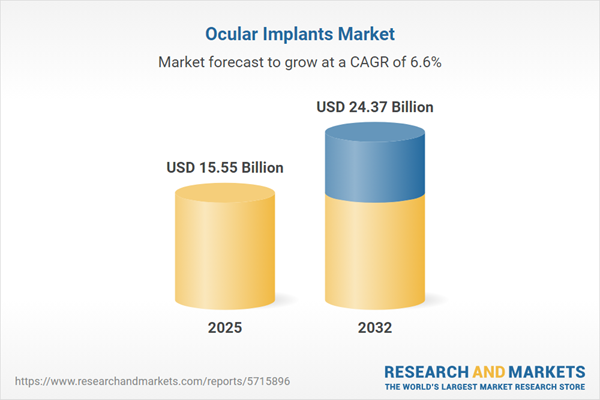Speak directly to the analyst to clarify any post sales queries you may have.
The ocular implants market is undergoing rapid evolution, powered by advancing bioengineering, heightened clinical expectations, and strategic responses to global supply chain dynamics. Senior decision-makers must navigate this environment to maintain competitive advantage and deliver optimal patient outcomes across multiple geographies and product classes.
Market Snapshot: Ocular Implants Market Size and Growth
The ocular implants market grew from USD 14.57 billion in 2024 to USD 15.55 billion in 2025. It is expected to continue growing at a CAGR of 6.63%, reaching USD 24.37 billion by 2032. This sustained expansion reflects the rapid uptake of advanced products addressing the needs of both aging populations and emerging regions. Market demand is influenced by broadening clinical applications, innovative materials, and regulatory adaptation, which are driving investment, product launches, and cross-border partnerships.
Scope & Segmentation: Comprehensive Coverage of the Ocular Implants Market
This report delivers targeted insights for executives seeking to understand and capitalize on emerging trends across the ocular implants ecosystem. Strategic segmentation covers a wide spectrum:
- Product Types: Corneal implants, glaucoma drainage devices, intraocular lenses (accommodating, extended depth of focus, monofocal, multifocal, toric), retinal prostheses, scleral buckles
- Applications: Cataract surgery, glaucoma treatment (including drainage device and micro invasive surgery), keratoconus correction, ocular trauma repair, retinal disorders
- Technologies: Accommodating, extended depth of focus, monofocal, multifocal, toric lens designs
- Materials: Acrylic, collagen, hydrogel, PMMA, silicone
- End Users: Ambulatory surgical centers, hospitals, ophthalmic centers, specialty clinics
- Distribution Channels: Direct tendering, distributor relationships, online procurement platforms
- Regions: Americas (United States, Canada, Mexico, Brazil, Argentina, Chile, Colombia, Peru), Europe, Middle East & Africa (United Kingdom, Germany, France, Russia, Italy, Spain, Netherlands, Sweden, Poland, Switzerland, United Arab Emirates, Saudi Arabia, Qatar, Turkey, Israel, South Africa, Nigeria, Egypt, Kenya), Asia-Pacific (China, India, Japan, Australia, South Korea, Indonesia, Thailand, Malaysia, Singapore, Taiwan)
- Key Companies: Alcon Inc., Johnson & Johnson Vision Care, Inc., Bausch & Lomb Incorporated, Carl Zeiss Meditec AG, HOYA Corporation, STAAR Surgical Company, Rayner Intraocular Lenses Limited, PhysIOL SA, Lenstec, Inc., Domilens SA
Key Takeaways for Senior Decision-Makers
- Breakthroughs in material science—such as enhanced acrylics and biocompatible polymers—are enabling new implant designs that optimize visual outcomes and reduce complications.
- The convergence of 3D printing, nanofabrication, and smart sensors facilitates the customization of implants and supports remote patient monitoring for improved care management.
- Cross-sector partnerships between established device companies, technology startups, and research institutions are accelerating the rate of technological adoption and expanding therapy portfolios.
- Health systems in regions such as North America and Asia-Pacific are prioritizing access through investment in surgical infrastructure, reimbursement innovation, and supply chain resilience.
- Digital imaging and AI tools are reshaping preoperative planning and postoperative monitoring, streamlining workflow and supporting more personalized intervention strategies.
Tariff Impact: Shaping Cost Management and Supply Chain Strategy
Recent tariff changes in the United States have imposed increased duties on imported ocular implant materials and microcomponents, directly affecting global cost structures. Manufacturers are leveraging supplier diversification, nearshoring, and regional production hubs to de-risk supply chains and offset inflationary pressures. Industry advocacy for tariff exemptions relevant to medical devices is underway, while regulatory relief and optimized customs processes are providing incremental financial mitigation. These measures are driving adjustments in product portfolio strategies and resource allocation for R&D, with a focus on modular designs and alternative materials.
Methodology & Data Sources
This report applies a rigorous research methodology, combining systematic reviews of peer-reviewed publications, regulatory filings, and patent analysis. Primary insights derive from interviews with ophthalmology thought leaders, device engineers, and materials scientists. Quantitative modeling is grounded in industry association data and validated by expert panel review, supporting robust trend identification and market projections.
Why This Report Matters for Stakeholders in the Ocular Implants Market
- Supports strategic investment decisions and product development, backed by granular segmentation and trend analysis tailored to board-level priorities.
- Equips commercial, regulatory, and supply chain leaders with actionable intelligence on tariff impacts, regional variances, and emerging technology pathways.
- Enables rapid adaptation and opportunity identification in response to evolving clinical, technological, and macroeconomic influences across global markets.
Conclusion
The ocular implants market offers significant potential for growth, differentiation, and patient benefit through innovation and agile supply chain management. Executives leveraging these insights can enhance resilience and deliver value in a complex medical device landscape.
Additional Product Information:
- Purchase of this report includes 1 year online access with quarterly updates.
- This report can be updated on request. Please contact our Customer Experience team using the Ask a Question widget on our website.
Table of Contents
3. Executive Summary
4. Market Overview
7. Cumulative Impact of Artificial Intelligence 2025
Companies Mentioned
The companies profiled in this Ocular Implants market report include:- Alcon Inc.
- Johnson & Johnson Vision Care, Inc.
- Bausch & Lomb Incorporated
- Carl Zeiss Meditec AG
- HOYA Corporation
- STAAR Surgical Company
- Rayner Intraocular Lenses Limited
- PhysIOL SA
- Lenstec, Inc.
- Domilens SA
Table Information
| Report Attribute | Details |
|---|---|
| No. of Pages | 196 |
| Published | November 2025 |
| Forecast Period | 2025 - 2032 |
| Estimated Market Value ( USD | $ 15.55 Billion |
| Forecasted Market Value ( USD | $ 24.37 Billion |
| Compound Annual Growth Rate | 6.6% |
| Regions Covered | Global |
| No. of Companies Mentioned | 11 |









